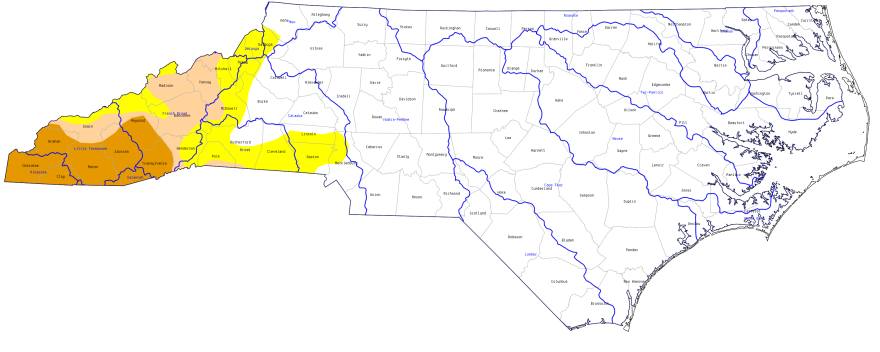It’s summertime in the mountains, and along with high temperatures, the season has also brought drought conditions to the region.
Believe it or not, Western North Carolina is experiencing a drought at the moment, despite the heavy rains and powerful storms that have passed through in recent weeks—its impact is being felt throughout many mountain communities.
On July 21, the North Carolina Drought Management Advisory Council released its weekly update on current drought conditions for the region. It reveals large swaths of what the council calls “severe drought conditions” which persist in the state’s seven westernmost counties, from Cherokee to Haywood Counties. Throughout these counties in the region, the report claims they are in a rainfall deficit of three to four inches.
In short, it’s proving to be one hot, dry summer in the mountains. How dry? Severely dry, says the report. However, it may be too early to tell just yet, says National Weather Service Hydrologist Josh Palmer.
“I don’t think the drought is particularly severe yet, but things are rapidly deteriorating.”
According to Palmer, if the region doesn’t start seeing more regular rainfall over the next three to four weeks, then the impacts that come with a severe drought will begin to manifest.
“What’s happening is we’re finally starting to catch up. We were so wet in the winter time that it took some time for the dryness to start to show up, in terms of impacts.”
But just what are the impacts that come with a severe drought? Aside from unsightly patches of grass on your neighbor’ s lawn, Palmer says that droughts typically hurt agricultural industries, as well as the public itself.
“It starts to impact the general public, I think, when we start to deal with water supply issues. When the reservoirs get to the point where its low enough, and they have to start implementing water restrictions in various communities, that’s when you’ll really start to see the public getting more interested in the drought. Of course farmers have maybe one of the firsthand knowledge of drought conditions.”
One such farmer is Steve Whitmire, of Clay County’s Ridgefield Farms.
“It’s a real problem. If you’re not irrigated, and you’re in agriculture, then you’re a hurting puppy in a drought. If you have irrigation, and you’re growing crops—you’re okay—as long as they’ll either let you withdrawal water from a well, or withdrawal water from a creek to irrigate.”
Unlike many farmers, Whitmire says that he’s fortunate enough to run an irrigated farm, but adds that droughts are still a problem for him.
“We were starting to hurt. We went almost four weeks without rain and then we got two and a quarter inches last week, and it helped. So, we’re thankful and we feel very lucky, because we don’t have to go far from here to get to where people have not had the rain. But right here, in beautiful Brasstown, North Carolina, we actually in the last few weeks got rain.”
Outside of the local agricultural industry, this year’s drought has also affected the region’s golf industry as well.
“It’s been one of the worst in the past few years,” that’s Steve Wyatt, manager of Macon County’s Franklin Golf Course. “
Wyatt’s worked at the nine hole course since 2002, and says that in all of his years of working there, he can only recall one or two droughts that have been as bad as this year’s.
“It causes us to have to water a lot more, and we have a limited supply of water, so the more we water, the lower our irrigation pond gets. At one point, my irrigation pond was down over three feet, and it’s only nine feet deep, so we’ve already used over a third of our water.”
But there are steps mountain residents can take to help respond to drought conditions, Palmer says.
Since March, the region began experiencing the current rainfall deficit .
According to Hydrologist Josh Palmer, of the National Weather Service, severe conditions like this have a strangling effect on the geography of the region. “It’s starving the soil of the moisture it needs in the summertime. It’s starving vegetation from the moisture it needs.”
The next three to four weeks or so, Palmer explains, will determine how Western North Carolina fares during this summer’s drought.
“I don’t think the drought is severe, yet. But things are rapidly deteriorating. If we don’t see enough rainfall over the next three or four weeks, we will almost certainly see things worsen to the severe drought conditions the region’s been classified as now. It’s really feast or famine at the moment.”
But there are steps mountain residents can take to help respond to drought conditions, Palmer says.
“Continue to conserve water, especially when watering your lawn or when you’re landscaping—I’m sure people are doing that more often as lawns continue to dry out. It’s always better to water your lawn in the early morning hours, than in the middle of the afternoon. Evaporation at that point in the day is at it’s peak. And just pay attention to your local communities. County officials, city officials, folks in charge of the water supply--follow what they recommend."
For WCQS News, I'm Davin Eldridge.





